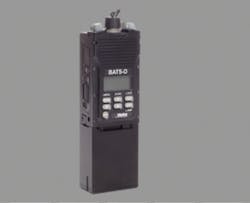U.S. military researchers needed secure small-form-factor Link 16 radio terminals to support a project to back-up military communications links with buoy and undersea optical fiber networks. They found their solution from ViaSat Inc. in Carlsbad, Calif.
U.S. Defense Advanced Research Projects Agency (DARPA) officials in Arlington, Va., announced plans to buy ViaSat Battlefield Awareness & Targeting System-Dismounted (BATS-D) AN/PRC-161 handheld Link 16 radio terminals sole-source for the agency’s Tactical Undersea Network Architectures (TUNA) program.
The ViaSat radios will support an at-sea demonstration as part of the second phase of the TUNA program, which aims at using optical fiber to restore radio frequency (RF) tactical data networks temporarily in a contested environment via an undersea optical fiber backbone.
The concept involves deploying RF network node buoys dropped from aircraft or ships that are connected via thin underwater fiber-optic cables. These very-small-diameter, fiber-optic cables will be able to last 30 days in the rough ocean environment, which is long enough to provide essential connectivity until primary methods of communications are restored.
The idea is to restore military communications links with buoy and undersea optical fiber networks when normal communications channels go down because of battle damage, electronic jamming, or other interference.
The TUNA program requires the smallest available radio solution to keep equipment size, weight, and power consumption (SWaP) to a minimum to improve deployability, increase endurance, and minimize observability.
The TUNA program’s second phase specifies Link 16 radios for the projects phase-two at-sea demonstrations because Link 16 is the best fit for the program, and helps take advantage of existing Navy radios. DARPA awarded a $19.3 million contract for the TUNA program’s second phase in March 2017 to Oceaneering International Inc. in Hanover, Md., to develop and demonstrate TUNA designs to restore connectivity for tactical data networks using small-diameter optical fiber and buoy relay nodes at sea. When the TUNA program’s second phase began last year, the smallest certified Link 16 radio was the ViaSat Small Tactical Terminal (STT), DARPA researchers explain. While this radio is smaller than Navy shipboard radio installations, it still is quite large with significant power requirements. The STT resulted in TUNA communications buoys that were cumbersomely large, heavy, and power-hungry.
The recently certified ViaSat BATS-D AN/PRC-161 handheld Link 16 radios, on the other hand, have begun production and are small enough to design TUNA buoys with significant SWaP reductions, and represent the only source to meet TUNA program objectives, DARPA officials say.
Certified as a Type 1 cryptographic device by the U.S. National Security Agency (NSA), ViaSat has just begun production of these ground-breaking radio, DARPA officials say. The BATS-D design and production comes just in time to offer a hardware solution that facilitates the fielding of small, high-endurance communications buoys.
The ViaSat BATS-D AN/PRC-161 radio fuses air and ground situational awareness in a handheld size. The ruggedized radio delivers real-time Link 16 communications small enough to be vest-worn, handheld, or mounted.
The radio offers users access to air and ground situational data and can provide secure target data and position location, identification, and status information to the network. The radio has J-Voice capability for direct voice communications with other Link 16 users.
The ViaSat BATS-D AN/PRC-161 radio provides a very small form factor and low-power tactical data link for unattended use in TUNA communications buoys that permit cross-domain communications that capitalizes on transferring communications and data for long distances over undersea fiber optical cable, DARPA officials say.
The small size and diminutive power requirements of the radios significantly reduce the size, improve the endurance, and improve the deployability of the communications buoys, which are critical to the functioning of the TUNA system.
For this demonstration project, DARPA officials say the plan to buy four BATS-D radios from ViaSat at a cost of about $300,000. For more information contact ViaSat online at www.viasat.com, or DARPA at www.darpa.mil.

